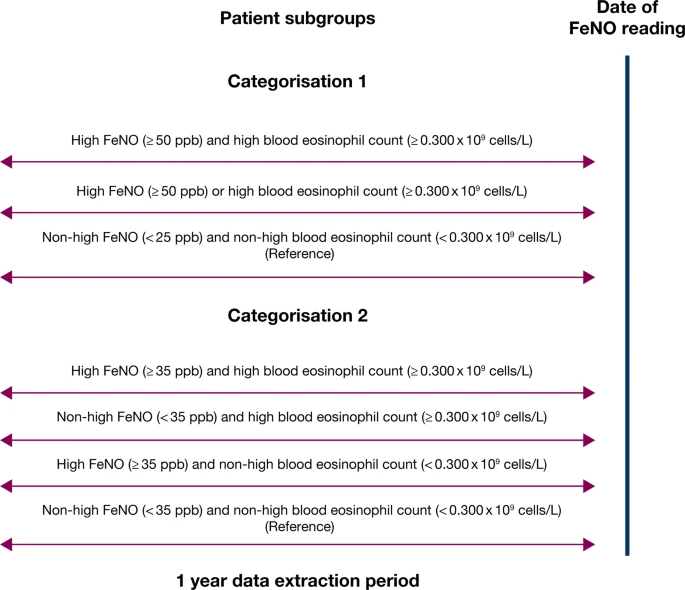Research – Open Access
David B. Price, Sinthia Bosnic-Anticevich, Ian D. Pavord, Nicolas Roche, David M. G. Halpin, Leif Bjermer, Omar S. Usmani, Guy Brusselle,
Simon Wan Yau Ming & Sarang Rastogi
Clinical and Translational Allergy volume 9, Article number: 41 (2019)
Abstract
Background
Blood eosinophil count (BEC) and fractional exhaled nitric oxide (FeNO) concentration are established biomarkers in asthma, associated particularly with the risk of exacerbations. We evaluated the relationship of BEC and FeNO as complementary and independent biomarkers of severe asthma exacerbations.
Methods

This observational study included data from the Optimum Patient Care Research Database. Asthma patients (18–80 years) with valid continuous data for 1 year before FeNO reading, ≥ 1 inhaled corticosteroid prescription, and BEC recorded ≤ 5 years before FeNO reading were separated into cohorts. Categorisation 1 was based on the American Thoracic Society criteria for elevated FeNO concentration (high: ≥ 50 ppb; non-high: < 25 ppb) and BEC (high: ≥ 0.300 × 109 cells/L; non-high: < 0.300 × 109 cells/L). Categorisation 2 (FeNO concentration, high: ≥ 35 ppb; non-high: < 35 ppb) was based on prior research. Reference groups included patients with neither biomarker raised.
Results

In categorisation 1, patients with either high FeNO or high BEC (n = 200) had a numerically greater exacerbation rate (unadjusted rate ratio, 1.31 [95% confidence interval: 0.97, 1.76]) compared with patients in the reference group. Combination of high FeNO and high BEC (n = 27) resulted in a significantly greater exacerbation rate (3.67 [1.49, 9.04]). Similarly, for categorisation 2, when both biomarkers were raised (n = 53), a significantly greater exacerbation rate was observed (1.72 [1.00, 2.93]).
Conclusion
The combination of high FeNO and high BEC was associated with significantly increased severe exacerbation rates in the year preceding FeNO reading, suggesting that combining FeNO and BEC measurements in primary care may identify asthma patients at risk of exacerbations.
